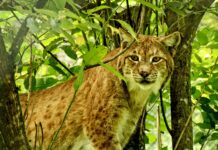How high tree species richness benefits human society.
Most ecosystems, like tropical rainforests or oceans, provide suitable environments for many different plant- and animal species. Furthermore, ecosystems provide a lot of benefits to humans, like health and economic benefits. We owe these ecosystems for a large part to the trees. But how exactly do they support ecosystems? And why is this important for policy-makers?

Groundbreaking tree diversity research
Recently, Gamfeldt and colleagues investigated the relationship between ecosystem services and tree species richness in boreal and temperate forests, which account for almost half of the world’s forests. To test the influence of the tree diversity, the scientists analyzed the data from over 4.000 sample plots in Sweden, each consisting of 314 m2 pure forest. These data were collected by forestry experts.

From each sample plot, the researchers collected the results of six ecosystem benefits or ecosystem services, namely (1) production of tree biomass, (2) soil carbon storage, (3) bilberry production, (4) understory plant species richness, (5) game production potential, and (6) dead wood. These ecosystem services should give a comprehensive picture of the abilities of boreal- and temperate forests. They used it for two types of analyses.
First, the researchers searched for the influence of single common tree species, namely spruce, pine, birch, oak, aspen and beech on the ecosystem services. They found that none of the six investigated trees is able to provide all ecosystem services on their own. For instance, birches primarily improve soil carbon storage and aspens only increase dead wood.
Second, Gamfeldt and colleagues tested whether five tree species in a sample plot supply more ecosystem services than one tree species. The number of five species is chosen, because it is the highest common diversity for the sample plots. One tree species is selected to clearly show the effect of multiple tree species in boreal and temperate forests. We will discuss each ecosystem service below.
- Production of tree biomass
Tree biomass is the sum of all tree material of the ecosystem. The production of biomass is massively increased with 54% in sample plots that contain five tree species compared to plots with only one tree species (from about 0,4 kg/m2/year to about 0,6kg/m2/year). A high production of tree biomass is very important for the global economy, currently contributing 400 billion US Dollar to the annual gross world product in terms of wood.
- Soil carbon storage
Soil carbon storage is slightly increased with 11% in sample plots with five tree species (from about 2,6 kg/m2 to about 2,9 kg/m2). Forests store about 45% of terrestrial carbon, so this slight increase can be very meaningful for decreasing carbon dioxide in the air in order to combat global warming.
- Bilberry production
Bilberries grow on plants called Vaccinium myrtillus. These plants are very difficult to cultivate, so bilberries need to be harvested in forests, primarily boreal and temperate forests. Like the tree biomass, the production of bilberries highly increased if sample plots contained five tree species instead of one tree species. The proportion cover increased with 45% (from approximately 11% to 16%). This increase is important, because bilberries are believed to be the new super fruits. They contain great concentrations of antioxidants and phytochemicals. These molecules are well-known for their protection against multiple diseases, including cancer heart disease and diabetes.
- Understory plant species richness
Understory plant species are the plants that live on, under, or around trees. These plants are adapted to live in a dark environment. Common examples are ferns and periwinkles, but also the aforementioned V. myrtillus (see image above). Sample plots that contain five tree species have more understory plant species richness proportion than plots with only one tree species. The difference is 31% (from 7,5% to about 10%). This ecosystem service provides aesthetic and recreational value to forest visitors.
- Game hunting
The game hunting (note 1) production potential is a measure to determine whether it is possible for hunters to hunt animals, usually birds or and mammals. This potential increased moderately by 20% with five in stead of one tree species (from 30% to about 36%). This potential has a recreational value and a high economic value. Recent figures reveal that hunters in the US alone spend 38 billion US dollars annually on hunting (i.e. materials, travel, etc.). Although game hunting is largely debated, responsible hunting on prevalent animal species does not harm the ecosystem. In fact, hunting on disrupting animals (like rats) can support the ecosystem.
- Dead wood
Wood is a supporting ecosystem service that assists the other services. This wood is necessary for nutrient cycling and soil formation. The amount of dead wood is only increased with more than six tree species.
Tree performance in perspective
This study shows a positive relationship between the amount of boreal- or temperate tree species and six ecosystem services, especially tree biomass production and bilberry production. The researchers explained the importance of multiple tree species by the inability of the common tree species to provide all ecosystem services. In other words: different tree species are complementary to one another.
There are more explanations for this complementarity. First of all, different tree species have different interactions with other organisms. Secondly, a diverse tree community has a higher resistance to tree disease. For instance, deer prefer to eat the acorns of the oak.
So what?
All in all, this study underlines the importance of conserving a variation of tree species. The researchers achieved it in a typical way, namely by connecting tree diversity with ecosystem services, which are both necessary and pleasant for mankind. Therefore, these outcomes are very interesting for policy makers. They can for instance decide to invest in forests with high tree species richness.
In the future, researchers should investigate the influence of high tree species richness on oxygen emission of the forest. Next, similar research could be done with other tree ecosystems, like tropical rainforests.
References
Gamfeldt L, Snäll T, Bagchi R, Jonsson M, Gustafsson L, Kjellander P, Ruiz-Jaen MC, Fröberg M, Stendahl J, Philipson CD, Mikusiński G, Andersson E, Westerlund B, Andrén H, Moberg F, Moen J, & Bengtsson J (2013). Higher levels of multiple ecosystem services are found in forests with more tree species. Nature communications, 4 PMID: 23299890





